Mapping the Driftless Area
Want this map?
My home is the Driftless Area — a landscape of rugged hills and coulees that unfolds in steep contrast to the plains of the surrounding Midwest. I’ve long wanted a good map of the area’s unique topography, but this desire has been hard to satisfy. The Driftless Area is flung across the borders of Iowa, Illinois, Minnesota, and Wisconsin, so no individual state map covers the whole region. Moreover, while there are a handful of maps out there centered on the Driftless Area, none that I’ve seen show quite what I want. There was just one solution: I would have to make a map of my own. I have no formal training in GIS or cartography, but maps have fascinated me since childhood, and there is no better excuse than ignorance for learning something new. It took some time, but at long last I’ve made the map I’d been looking for.
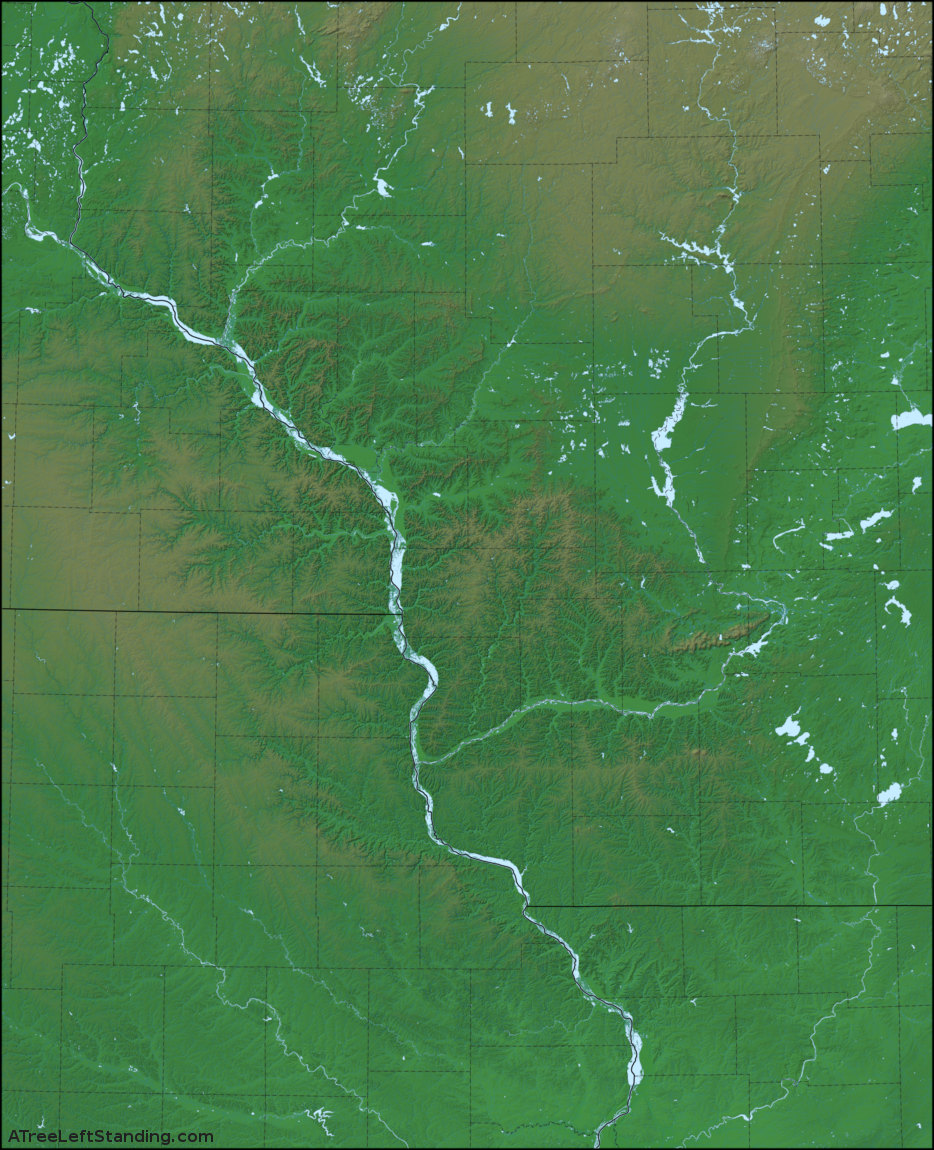
The Making of the Region
The Driftless Area takes its name because it is comparatively free of glacial “drift,” the silt and stone carried elsewhere by ice age glaciers. Though prehistoric ice sheets passed the Driftless Area on all sides, this region mostly escaped the scouring glaciation that flattened the neighboring countryside. As a result, the Driftless Area exhibits a more timeworn terrain, visible on the preceding map as a swath of rough relief stretching from northwest to southeast. For all its hills, the area is not mountainous — its highest elevation, at West Blue Mound in Wisconsin, is only 1,719 feet above sea level. In fact, the Driftless Area was built up from sediment in a shallow Paleozoic seabed. Ever since the region rose out of the sea hundreds of millions of years ago, streams have been eroding deep, fractal-like drainage channels into the land, creating its present rough surface.1
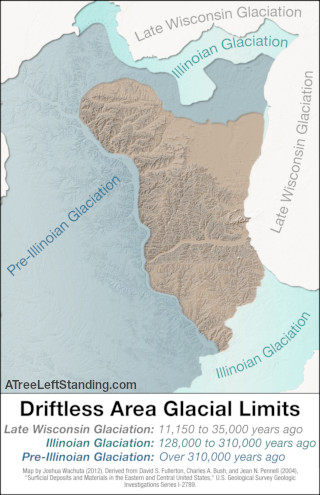
During the last 2.5 million years, ice sheets repeatedly advanced and retreated around the Driftless Area. The accompanying map shows the estimated limits of these glacial advances. The most recent glacial maximum, called the Late Wisconsin, can be mapped with great accuracy. In the Late Wisconsin period, ice sheets spanned from Canada to southern Ohio, leaving behind the lakes, drumlins, and moraines that characterize the geography of eastern and northern Wisconsin. Glaciers in this period did not penetrate the Driftless Area, however. Earlier glacial periods are more difficult to map with precision, but it seems clear that the Illinoian Glaciation also passed around the Driftless Area. On the other hand, geologists have unearthed scattered Pre-Illinoian glacial deposits in the western and far northern portions of the Driftless Area. By definition, Pre-Illinoian glaciation took place at least 310,000 years ago. The ice that once encroached into the Driftless Area probably came even earlier — the magnetic polarity of the region’s glacial deposits indicate that they were formed more than 790,000 years before present. As a result, evidence of that early glaciation has had time to mostly erode away.2
The erosion of the Driftless Area was exacerbated by cataclysmic floods that followed each glacial period. During the last glacial phase, meltwater pooled along the northeast periphery of the region, where a combination of ice and hills held back Glacial Lake Wisconsin. The lake created a broad, sandy bed that remains visible today as flat expanse of lowlands across the central part of the state. When this prehistoric lake overcame its constraints, it unleashed floods that eroded the present valleys of the Black River and the Lower Wisconsin River. Similar outpourings of glacial meltwater molded the Chippewa River and Mississippi River valleys. The last retreat of glaciers from Wisconsin between 14,000 and 10,000 years ago established these rivers in their present courses, leaving the Driftless Area essentially in its modern form just as the first humans made their way into the landscape.3
The Making of the Map
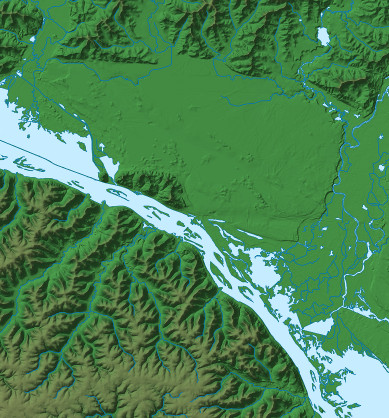
I wanted my map of the Driftless Area to reveal at a glance the shape of the natural landscape. Human development and labels were less important, as I can find road maps from Yahoo! and Google, and in any case, the cultural features of the Driftless Area tend to rise from their natural surroundings. River valleys such as the Mississippi and Wisconsin doubled as arteries of trade and transportation. Alluvial terraces became building sites for towns and cities like Winona, La Crosse, and Prairie du Chien. Stretches of highland like Military Ridge became thoroughfares linking upland settlements, and prominent features like the Blue Mounds and Trempealeau mountain have long served as landmarks for passersby. A map that makes these natural features visible will therefore expose the foundations of human geography in the region.
After deciding on an emphasis for my map, I needed to collect the geospatial data and software needed to make it. I was able to complete the map with public domain data from U.S. government agencies. To process this data, I relied exclusively on free open source software. GRASS (with GDAL and OCR) did the heavy work of rendering my data sources into graphical map layers, while Inkscape and GIMP aided me with further graphic editing and layer compositing — all on a GNU/Linux operating system.
Land elevation formed the basis for my map. I downloaded local elevation data from the National Elevation Dataset (NED) maintained by the United States Geological Survey. The NED is a raster or grid of elevation measurements spaced at every 1 arc second (1/360th of a degree, or approximately 30 meters) across the entire contiguous United States (other levels of detail, such as measurements at every 1/3 arc second, are also available). I used GRASS to map these elevation measurements in three ways. First, I defined a different color to mark each elevation level — rising from green lowlands to brown uplands. This is a cartographic technique known as “hypsometric tinting,” and it serves to fill the map with color while making it easy to compare the height of distant locations at a glance. Second, I instructed GRASS to draw simulated shadows behind rises of elevation, creating a classic “shaded relief” map. This provides a three-dimensional illusion of the rise and fall of terrain. Finally, in addition to traditional relief shading, I also utilized GRASS to draw subtle “slope shading,” making steeper areas appear slightly darker than flat areas. This outlines hillsides even at angles that standard shaded relief would miss.
As I created these three elevation layers, I also needed GRASS to project my renderings onto a plain — the earth is round, but maps are flat. There is no perfect way to depict the spherical surface of our planet in two dimensions, and as a result cartographers have designed countless map projections that compromise shape or scale in different ways to make the best approximations for different needs. I used the transverse Mercator projection for my map of the Driftless Area, as that projection is ideal for mapping small regions that are longest from north to south. Below are samples of my three elevation renderings — hypsometric tinting, shaded relief, and slope shading — each as a transverse Mercator projection:
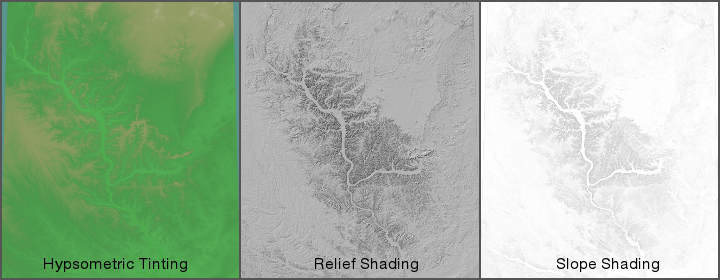
After mapping elevation, I added a few more elements. Streams are responsible for the erosion that created the Driftless Area’s topography, so I wanted to show water features in as much detail as possible. I was able to obtain outlines of streams and waterbodies from the USGS National Hydrography Dataset and the U.S. Census Bureau’s TIGER mapping service. I also downloaded state and county boundary definitions from the Census Bureau. Although I left out other human features on my map, I included boundaries to serve as a location reference and enable easy comparisons with maps that emphasize man-made features. As before, I rendered both the water features and boundaries as a transverse Mercator projection using GRASS. I then turned to Inkscape to color and pattern each set of features, creating the maps below:
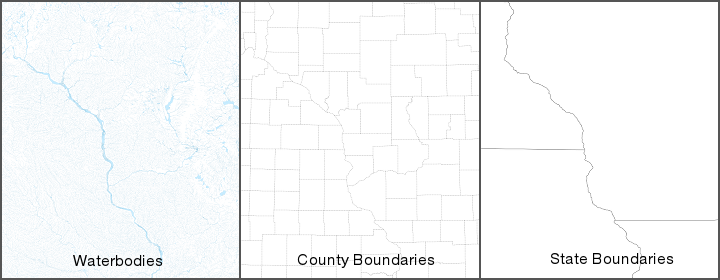
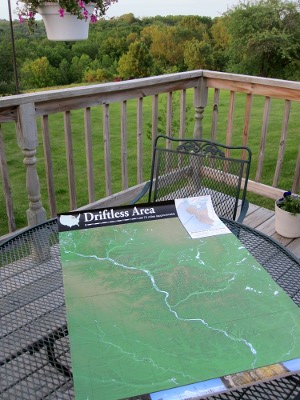
When I had at last prepared each layer of the final map — state and county boundaries, water bodies, and three renderings of elevation — I used GIMP to stack the layers together. The resulting composite map was shown at the start of this article.
I still was not done. It was not enough merely to pan across the map on my computer screen — the only way to study the whole region in detail would be to order a large format print of the map. A print would need to be as polished and informative as possible, so I went back to the USGS for more data and used GRASS and GIMP to create a map of local glaciation (included in part one of the article) as well as a locator map based on the contiguous United States. I inset these additions onto the main map for added reference value in the final printed version. Finally, I embellished the map with photographs showing four seasons of Driftless Area natural scenery. I sent the design away to be printed, and in a few days, I had the map in my hands as a 24 by 36 inch poster.
How to Get a Copy
This map was made to be shared. You can get the 24 by 36 inch print for yourself by ordering the Driftless Area Map Poster from Zazzle. I wouldn’t hawk the poster if it wasn’t absolutely the best way to see the map in all its detail. A portion of your purchase also helps keep this website alive and free of outside advertising.
Get the Driftless Area Map Poster (24 by 36″)
Not ready to buy the poster? No worries! I’m also giving the map away as a 1280-pixel JPG for screen viewing. It’s not quite the same as having the print for your wall, but it is free. Just right click on
Download the Driftless Area Map and select the “Save” option from your browser’s context menu.
Notes and References:
- Robert H. Dott, Jr., and John W. Attig, Roadside Geology of Wisconsin, (Missoula, Montana: Mountain Press Publishing Co., 2004), pp 119-128, 158.
- David S Fullerton, Charles A. Bush, and Jean N. Pennel, “Surficial Deposits and Minerals in the Eastern and Central United States (East of 102 Degrees West Longitude),” U.S. Geological Survey Geologic Investgation Series I-2789, (2004). [http://pubs.usgs.gov/imap/i-2789/]; Dott and Attig, pp 131-134.
- James Theler and Robert F. Boszhardt, Twelve Millenia: Archaeology of the Upper Mississippi River Valley, (Iowa City: University of Iowa Press, 2003), pp 19-32; 58-68; Dott and Attig, pp 134, 166-179, 199-205.